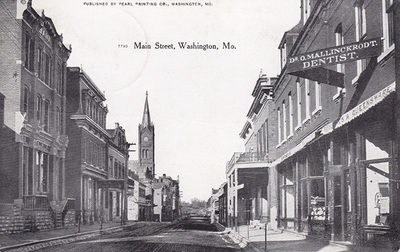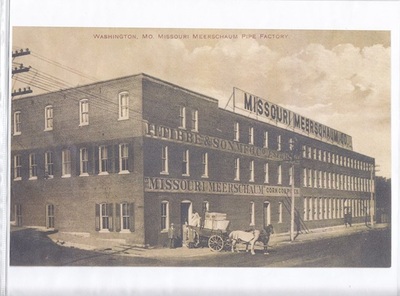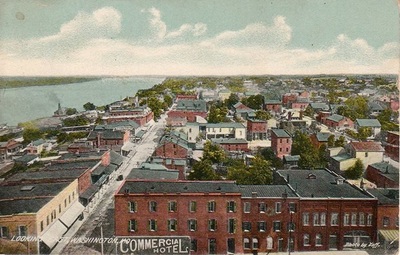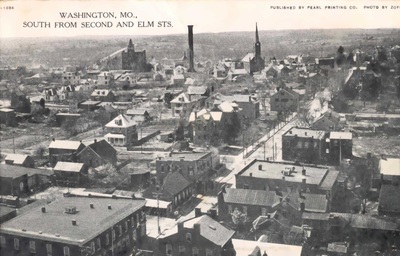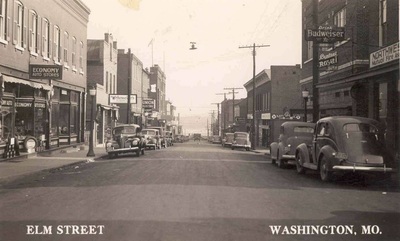Washington's History
|
Washington . . . A beautiful, historic river town with a distinctive German heritage located in the heart of Missouri Wine Country… Washington is just minutes off I-44 between St. Louis and Branson. Washington’s rich history includes such famous individuals as Daniel Boone and Lewis & Clark.
Some of the earliest settlers in the Washington area were literally followers of Daniel Boone, who had blazed a trail from the hills of Kentucky to the wilderness of east-central Missouri. The German populace for which Washington is known began with the arrival of twelve Catholic families in the fall of 1833. This group and other later German immigrants were sometimes called “followers of Gottfried Duden,” who for two years lived at nearby Dutzow and wrote glowing reviews of the area for readers in his homeland. The lush, green, rolling hills and the river valley reminded Duden of the area from which he came. A natural river landing, at what was to become the Washington site, made this an ideal place to begin a settlement. In the first three decades of the nineteenth century, the small community grew upon the gently sloping hillside on the south bank of the Missouri River. William G. Owens and his wife Lucinda settled in the area in 1818. They eventually purchased most of the land that would become known as “downtown” Washington, which included about fifty acres. Town lots were sold at auction in 1829. However, in 1834, Owens was murdered, and legal entanglements in his estate blocked the establishment of the new town. His widow Lucinda would eventually receive clear title to the town’s core, and on May 29, 1839, she filed a plat at the county courthouse thus establishing the city of Washington. Ferryboats served the community from the early 1800’s until the bridge was completed in 1936. In 1854, John B. Busch, an older brother of the famous Adolphus Busch, established a brewery in Washington, bottling the first Busch Beer. The Pacific Railroad laid lines as far as Washington by 1855. An Austrian immigrant, Franz Schwarzer, began the manufacture of his world-famous zithers in 1866. Henry Tibbe and his son Anton began making corncob pipes in 1869; that business would help put Washington, Missouri, on the map as the “Corncob Pipe Capital of the World.” Many of Washington’s historic structures remain today, proudly standing as reminders of times past and evidence of the pride and determination of our fore-fathers. For more history on Washington, Missouri, be sure to visit the Washington Historical Society Museum at Fourth and Market Streets or go to the web site, www.washmohistorical.org. |
MUSEUMS
The Farmhouse at the Kohmueller Farmstead
Grand and Lakeshore Drs., Washington 636-239-0280 The Kohmueller farmhouse, built in 1879, is the typical brick home of the early German emigrants from the Osnabruck. Restored by Washington Preservation, Inc., the farmhouse is the site of many living history events each year. Tours available March through November by calling the Washington Historical Society Museum at the number listed. Historical Society Museum
4th & Market Streets, Washington 636-239-0280 The museum encompasses about 6,000 square feet and provides space for exhibits and historical and genealogy paper records. Items exhibited at the museum are those things relative to the history of Washington, Missouri and its immediate surrounding area. It includes corn-cob pipes, zithers, Busch beer, pottery, Missouri River, Native Americans, World Wars I and II, art, photographs, advertising pieces, and some furnishings and items used in daily life. Open Sundays from 1 p.m. to 4 p.m., Tuesday - Saturday from 10 a.m. to 4 p.m. Closed on Mondays and major holidays and during January and February. Firehouse Museum
Fifth & Stafford Streets, Washington The Firehouse Museum is not open under regular hours but tours may be arranged by calling the Historical Society Museum at 636-239-0280. |



